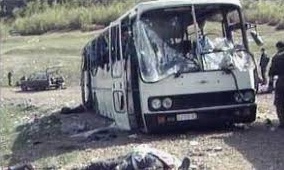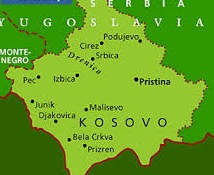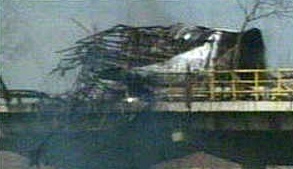
The Independent, 17 April 1999
This atrocity is still a mystery to Nato. Perhaps I can help…
By Robert Fisk

When you stand at the site of a massacre, two things happen. First, you
wonder about the depths of the human spirit. And then you ask yourself how
many lies can be told about it. The highway of death between Prizren and
Djakovica – on which the Serbs say Nato slaughtered 74 Kosovo Albanian refugees
in a series of bombing raids – is no different.
Only hours after I slipped on a dead man’s torso near an old Turkish bridge,
less than a day after I stood by the body of a young and beautiful girl –
her eyes gently staring at me between half-closed lids, the bottom half of
her head bathed in blood – I watched James Shea, Nato’s spokesman, trying to
explain yesterday why Nato still didn’t know what had happened on Wednesday.
All those torn and mangled bodies I had just seen – the old man ripped in half
and blasted into a tree at Gradis, the smouldering skeleton with one bloody,
still flesh-adhering foot over the back of a trailer at Terezick Most, the
dead, naked man slouched over the steering wheel of a burnt tractor – all,
apparently, were a mystery to Nato. So perhaps The Independent can
help clear up this unhappy state of affairs with some evidence – damning
span>perhaps, certainly important – from the scene.
But first a pause, to reflect on atrocities. The Serbs are “ethnically
cleansing” Kosovo. It is a war crime. If Nato massacred the 74 Albanians, the
Serbs have killed many more.
On Thursday, I saw four buses in Kosovo packed with terrified Albanian
women and children and old men, black curtains at the windows of the buses
in an attempt to hide their presence. Andat a square in the otherwise deserted
town of Pozeranje, near Urosevac, I passed at least 200 pathetic Kosovo
Albanians, exhausted, frightened, carrying plastic bags of clothes and battered
holdalls, the old women in scarves, the young women clutching children to their
bosoms, the old men wearing black berets; all were standing tightly together
for protection, like animals.
They were waiting for another bus, I suppose – and, not for the first time
these past three weeks, I thought of other scenes, in Eastern Europe just
over half a century ago. At Pozeranje, I was seeing these poor people – for a
few seconds only, from a vehicle window at the very moment of their
dispossession, on the very day of their “cleansing”, within hours of their
arrival among the flotsam of humanity along the Serbian border 12 miles away
It was a wickedness I saw, the very moment of evil. When I drove through
Pozeranje again yesterday, it was empty save for four horses running lose on
the main road.

So why dwell on the 74 dead Kosovo Albanians whose remains have been left
in such indignity along the Prizren-Djakovica road? Because the Serbs wanted us
to see them? Because Nato was already embarrassed by the Serb claims of their
slaughter? Because it “evens the balance” – it does not – between Serbia and
its enemies? No, I suspect that the road of death and its terrible corpses is
a challenge not to Nato’s propaganda but to its morality.

Nato, we are repeatedly told, represents “us”, the good moral, decent people
who oppose lies and murder. So Nato has a case to answer – for all our
sakes. And the evidence lies on that awful road with its eviscerated people
and its bomb craters. Nato “thinks” it bombed a tractor on a road north of
Djakovica.

Indeed, Nato’s military spokesman would say yesterday only that
is was “possibly” a tractor. Mr Shea – or “Jamie” as he enjoins us to call him
– says he is still trying to find out what happened to the 74 refugees. Nato
needs more time, he tells us, to assess what it bombed and
did not bomb.
Well perhaps I can help Jamie to speed up his enquiries. Of the four
air-strike locations, I have visited the first three – at Velika Krusa,
Gradis and Terzick Most – and they run consecutively from east to west along
the Prizren-Djakovica road. At the third, I came across four bomb craters.
I saw – and in some cases collected – a number of bomb and missile parts. At
Gradis, I came across part of a missile circuit board, its congealed wiring
attached to a plate which contains a manufacturer’s code.
Yesterday’s Independent carried some of this. But Nato will need the fullest
possible information to trace this piece of ordnance quickly. The full
codes (the brackets are empty on the original) reads as follows:
SCHEM 872110 ( ) 96214ASSY8721122 – MSN63341 [remaining figures obscured by
detonation damage]
It shouldn’t take Nato armaments experts more than a few hours to find out where
that code came from – indeed what aircraft carried and fired that
missile. Its pilot – if it was a Nato bomb – will then be able to explain why
he fired it.

At Velika Krusa, I found the fusing of an aerial bomb next to a smashed
trailer containing the belongings of 35 Albanian refugees, four of whom – all
women – were killed in this air strike. I also have in my possession what may
be a swivel system to an aerial bomb. It is one-inch square, very damaged (Xs
stand for the illegible parts) – but carries the code: “X6214 – 837XNY”.
At Gradis, I found a large bomb part, green in colour but with stencilled
colour code in English, whose full code
WING ASSEMBLY
96214ASSY
78-201872 872128
DATE OF MFG 3/78
Another similar bomb part contained the numbers:
96214ASSY
887760-4
At Gradis, too, part of what appeared to be a detonator contained a section
of manufacturer’s name:
TER Co Inc
13250
Again, Nato intelligence authorities should be able to work out some of
those codings within a few minutes.
Another piece of a bomb had the single word “BENDIX” stamped on the metal.
Other bomb and missile fragments contained moving fin assembly parts.
Most of the shrapnel was so sharp it that it cut the hands of those who
touched it. The corpses showed what happened when the bomb parts shredded
them alive. One of the bodies lying in a field at Terezicki Most – that of a
man in his 40s – had the top of his head cut cleanly off, along with his
brain and eyes so that his face had turned into an actor’s mask.
A. middle-aged woman in a purple pullover and brightly flowered skirt with her
eyes open and a pale waxen face, had had her neck cut open.Now, maybe Nato
will find that these bomb and missile assembly parts belonged to weapons sold
to other governments. Perhaps they will be able to claim that a Balkan nation
was given the aerial bomb whose wing assembly number is recorded above. In which
case, maybe Nato will say that the Yugoslav air force – of which not a
single aircraft has been seen in the air since the start of the Nato
bombardment – carried out this massacre of Albanian refugees.
Certainly, Yugoslav army officers at the bomb sites made no attempt to
prevent photographers taking pictures of the larger pieces (though they
showed no interest in the codings and seemed unable to understand my
interest). And I saw one photographer drag a piece of bomb several metres and
turn it over for a better photograph.But given the time available and the
chaos on the road – Nato air raids were going on within a mile of us as we
examined the bomb sites – it is impossible to believe that the Serbs
had time to construct these terrible scenes.
At Gradis, there was evidence of strafing as well as aerial bombing.
Huge troughs had been cut into the earth, each two feet in length,
separated by up to 10 feet and unevenly separated as if a drunken monster
had lurched through the field and on to the road. These appeared identical
to the cannon fire marks I found at the scene of American A-10 “Tankbuster”
strikes in the 1991 Gulf War. But there were no burnt-out tanks on the
Prizren-Djakovica road; only tractors and trailers and an old milk-yellow van
turned inside out by the explosion which destroyed it.
Along miles of the same road were other tractors, some scorched, most
abandoned, apparently in panic, at the side of the road. The few Kosovo
Albanians we found spoke of thousands on the road that day – 14 April – and
it appears that they were moving in both directions. Survivors have said
they came from the border, were moved to Djakovica and then told by Serb
forces to move to Prizren. Most say they had no Serb escorts. I saw those
awful buses with the black curtains moving in both directions near Prizren
on Thursday.
“Ethnic cleansing” is not a precise art. Nor is fear. Undoubtedly some of
the Kosovo Albanians on the road were terrified of the aircraft
which bombed them in four separate locations. The fourth attack took place
at Meja on the other side of Djakovica.
It wasn’t difficult for me to imagine the terror on that road. While we were
picking our way through the corpses of Terezicki Most, Nato planes dropped
bombs less than a mile away – cluster bombs from the sound of them – and a
series of massive explosions changed the air pressure around us. We watched
the skies. From time to time, we could hear – but not see – Nato jets
power-diving. Columns of dark smoke billowed over the bright green fields.
But we found no military wreckage. Not a smashed rifle, not a piece of armour.
There was a lot of glass on parts of the road – not a commodity to find in
large amounts on military vehicles. The only victims of these air strikes
appeared to be civilians. At Terezicki Most, I counted 13 corpses and other
body parts. A missile had rammed a tractor, setting fire to its trailer
and incinerating all inside. In the Prizren hospital mortuary, six corpses
lay on the concrete floor.
There was a woman, breasts exposed, on the right, a delicate child close
to her with a bloodied face. A piece of paper with the number “1” written
on it had been pinned to the shroud half covering an unknown man. We had
names for the rest: Fikrija Sulja, Imer Celja, Ferat Bajrami, Persad Sanfjli
and Nerdgivare Zecin.
Along the road, there were clothes and rags and broken cups and saucers beside
the bomb sites and photograph albums and family snapshots. I picked up
photographs of a pretty young Kosovo Albanian woman with a lace blouse and
curls and long black earrings, of a smiling four-year old boy in a T-shirt
standing on a sofa behind a vase of sunflowers, of the boy’s parents and
two other brothers on the same sofa, of two old women in Muslim scarves and of
a blood group certificate – Rhesus positive – for a woman named Rama
Resmije, dated 16 March 1993.
Did she live or die? Were the little boy and his parents and brothers torn
apart in the air strikes on Wednesday? And what of the pretty woman in the
earrings? If they survived, they deserve to know why their family and
friends died. If they were killed, we deserve to know why. That these people
were massacred in air strikes I do not doubt. I fear very much that they were
slaughtered by Nato. If so, why? Was this some terrible error about which
Nato – after its attack on a passenger train last week – fears to tell us? Or
did some Nato pilots (and this massacre needed three or four planes) make an
error and agree to cover it up? Or -most awful of all – did a Nato pilot do
something terrible, inexplicable, two days ago and then lie about it?
Nato, I suspect, can tell us. And those of us who walked among the innocent
dead on the road from Prizren to Djakovica this week are waiting to hear
Jamie tell the truth.